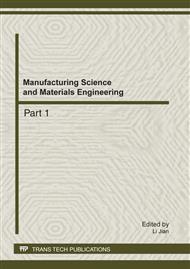[1]
J. C. Bean, J. R. Birge, J. Mittenthal, et al., Matchup scheduling with multiple resources, release dates and disruptions, Operations Research, vol. 39, 3, 1991, pp.470-483.
DOI: 10.1287/opre.39.3.470
Google Scholar
[2]
S. D. Wu, R. H. Storer, and P. C. Chang, One-machine rescheduling heuristics with efficiency and stability as criteria, Computers and Operations Research, vol. 20, 1, 1993, pp.1-14.
DOI: 10.1016/0305-0548(93)90091-v
Google Scholar
[3]
I. Sabuncuoglu and M. Bayiz, Analysis of reactive scheduling problems in a job shop environment, European Journal of Operational Research, vol. 126, 3, 2000, pp.567-586.
DOI: 10.1016/s0377-2217(99)00311-2
Google Scholar
[4]
C. Shangguan, H. Zhou, R. Shi, et al., Flow shop rescheduling problem and its improved repair-based constraint satisfaction algorithm, Computer Integrated Manufacturing Systems, vol. 14, 009, 2008, pp.1742-1751.
Google Scholar
[5]
M. Pinedo, Scheduling: Theory, Algorithms, and Systems, Second edition ed. Upper Saddle, New Jersey: Prentice-Hall, (2002).
Google Scholar
[6]
T. E. Morton and D. W. Pentico, Heuristic Scheduling Systems: With Applications to Production Systems and Project Management: New York : Wiley-Interscience, (1993).
Google Scholar
[7]
B. Lowerre, The HARPY speech recognition system, Carnegie-Mellon University, Pittsburgh, (1976).
Google Scholar
[8]
C. Shangguan, H. Zhou, and R. Shi, Filtered Beam Search Algorithm with Partial Backtracking and Its Application to Job Shop Scheduling, Systems Engineering theory & Practice, vol. 27, 001, 2007, pp.143-151.
Google Scholar
[9]
I. Sabuncuoglu, Y. Gocgun, and E. Erel, Backtracking and exchange of information: Methods to enhance a beam search algorithm for assembly line scheduling, European Journal of Operational Research, vol. 186, 3, 2008, pp.915-930.
DOI: 10.1016/j.ejor.2007.02.024
Google Scholar
[10]
J. M. S. Valente, Beam search heuristics for the single machine early/tardy scheduling problem with no machine idle time, Computers & Industrial Engineering, vol. 55, 3, 2008, pp.663-675.
DOI: 10.1016/j.cie.2008.02.005
Google Scholar
[11]
E. Tsang, Foundations of constraint satisfaction. London: Academic press Limited, (1993).
Google Scholar
[12]
R. Dechter, Constraint processing. San Francisco: Morgan Kaufmann, (2003).
Google Scholar
[13]
S. Minton, M. Johnston, A. Philips, et al., Minimizing conflicts: a heuristic repair method for constraint satisfaction and scheduling problems, Artificial Intelligence, vol. 58, 1-3, 1992, pp.161-205.
DOI: 10.1016/0004-3702(92)90007-k
Google Scholar
[14]
M. Tounsi and S. Ouis, An Iterative local-search framework for solving constraint satisfaction problem, Applied Soft Computing, vol. 8, 4, 2008, pp.1530-1535.
DOI: 10.1016/j.asoc.2007.12.006
Google Scholar
[15]
N. Yugami, Y. Ohta, and H. Hara, Improving repair-based constraint satisfaction methods by value propagation, 1994, pp.344-344.
Google Scholar


